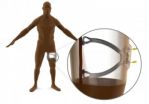(Press-News.org) Johns Hopkins University graduate students have invented a device to reduce the risk of infection, clotting and narrowing of the blood vessels in patients who need blood-cleansing dialysis because of kidney failure.
The device, designed to be implanted under the skin in a patient's leg, would give a technician easy access to the patient's bloodstream and could be easily opened and closed at the beginning and end of a dialysis procedure.
The prototype has not yet been used in human patients, but testing in animals has begun.
The students learned about the need for such a device last year while accompanying physicians on hospital rounds as part of their academic program. They watched as one doctor performed a procedure to open a narrowed blood vessel at a kidney patient's dialysis access site. They learned that this narrowing was a common complication facing kidney patients.
The students discovered that kidney failure each year requires 1.5 million people globally and 350,000 in the United States alone to undergo regular hemodialysis to prevent a fatal buildup of toxins in the bloodstream. The students also learned that the three most common ways to connect the machine to a patient's bloodstream work only for a limited time because of problems with infection, blood clots and narrowing of the blood vessels. Current dialysis access options are "grossly inadequate," contributing to increased healthcare expenses and, in some cases, patient deaths, the students say.
To address these problems, the students developed an access port that can be implanted in the leg beneath the skin, reducing the risk of infection. The Hemova Port's two valves can be opened by a dialysis technician with a syringe from outside the skin. The technician can similarly close the valves when the procedure is over, an approach that helps avoid infection and clotting. The device also includes a simple cleaning system, serving as yet another way to deter infections.
Currently, most dialysis access sites are in the arm or the heart. The Hemova device instead is sutured to the leg's femoral vein, avoiding the unnaturally high blood flows that cause vessel narrowing when dialysis machines are connected to veins and arteries in the arm. The student inventors say the Hemova Port's leg connection should allow the site to remain in use for a significantly longer period of time.
The port won a $10,000 first prize for Johns Hopkins graduate students in the 2011 ASME Innovation Showcase. The competition, involving 10 collegiate teams, was conducted in Texas earlier this month at the annual meeting of ASME, founded in 1880 as the American Society of Mechanical Engineers. Judges based their awards on technical ingenuity, quality of business plans, potential for success in the marketplace and other factors.
The five biomedical engineering students on the team were enrolled in a one-year master's degree program in the university's Center for Bioengineering Innovation and Design. Sherri Hall, Peter Li, Shishira Nagesh, Mary O'Grady and Thora Thorgilsdottir all recently graduated, but Li has remained in Baltimore to form a company that will continue to test and develop the project.
With help from the Johns Hopkins Technology Transfer staff, the team has filed for three provisional patents covering their technology. The patents list the five students and three medical faculty advisers as the inventors.
"Winning first-place in the ASME competition is a great honor," Li said. "The award and the recognition will go a long way toward helping to continue further research, and we hope it will bring us closer to the day when our device is available to help dialysis patients."
The Hemova team has applied for a $50,000 grant to conduct more animal testing in the coming months. Clinical trials involving human patients could begin as soon as 2013, the students said.
INFORMATION:
The students' clinical advisers were Johns Hopkins School of Medicine faculty members Thomas Reifsnyder, an assistant professor of surgery; and Kelvin Hong and Clifford R. Weiss, assistant professors of radiology.
Student team invents device to cut dialysis risk
2011-06-28
ELSE PRESS RELEASES FROM THIS DATE:
Zinger Replaces Printed Posters With New Digital Poster Kiosks
2011-06-28
Zinger Digital Signs today introduced eight new free-standing digital poster kiosk solutions for the retail and office/corporate markets. The digital signage poster kiosks are aimed at replacing printed posters used in retail and corporate environments. The new digital poster kiosks are certified for true 24/7 operations in commercial applications.
Digital posters offer many benefits to printed posters including savings from printing, shipping & handling. Digital posters can be updated instantly, giving retailers a tremendous benefit for those last minute sales or ...
Tapping titanium's colorful potential
2011-06-28
A new, cost-effective process for colouring titanium can be used in manufacturing products from sporting equipment to colour-coded nuclear waste containers.
"The new method uses an electrochemical solution to produce coloured titanium, improving on an older, time-consuming and expensive method where heat was used to develop a coloured layer," says Gregory Jerkiewicz, a professor in the Department of Chemistry.
Dr. Jerkiewicz's new technique can be finely tuned to produce over 80 different shades of basic colours. In addition, the coloured titanium produced using the ...
Marketing expert finds attachment to cellphones more about entertainment, less about communication
2011-06-28
MANHATTAN, Kan. -- That panicked feeling we get when the family pet goes missing is the same when we misplace our mobile phone, says a Kansas State University marketing professor. Moreover, those feelings of loss and hopelessness without our digital companion are natural.
"The cellphone's no longer just a cellphone; it's become the way we communicate and a part of our life," said Esther Swilley, who researches technology and marketing. This reliance on cellphones and other mobile technology in daily life is an interest of Swilley's, and a phenomenon she hopes to explain.
One ...
Does grilling kill E. coli O157:H7?
2011-06-28
Top sirloin steaks have been getting a grilling in U.S. Department of Agriculture (USDA) food safety studies. USDA microbiologist John B. Luchansky and his colleagues are conducting experiments to help make sure that neither the foodborne pathogen Escherichia coli O157:H7 nor any of its pathogenic relatives will ruin the pleasure of eating this popular entrée.
The scientists are learning more about the movement of E. coli into "subprimals," the meat from which top sirloin steaks are carved. Their focus is on what happens to the E. coli when subprimals are punctured-as ...
Fidgeting your way to fitness
2011-06-28
Walking to the photocopier and fidgeting at your desk are contributing more to your cardiorespiratory fitness than you might think.
Researchers have found that both the duration and intensity of incidental physical activities (IPA) are associated with cardiorespiratory fitness. The intensity of the activity seems to be particularly important, with a cumulative 30-minute increase in moderate physical activity throughout the day offering significant benefits for fitness and long-term health.
"It's encouraging to know that if we just increase our incidental activity slightly--a ...
Scientists measure body temperature of dinosaurs for the first time
2011-06-28
Were dinosaurs slow and lumbering, or quick and agile?
It depends largely on whether they were cold- or warm-blooded.
When dinosaurs were first discovered in the mid-19th century, paleontologists thought they were plodding beasts that relied on their environment to keep warm, like modern-day reptiles.
But research during the last few decades suggests that they were faster creatures, nimble like the velociraptors or T. rex depicted in the movie Jurassic Park, requiring warmer, regulated body temperatures.
Now, researchers, led by Robert Eagle of the California Institute ...
New procedure treats atrial fibrillation
2011-06-28
Doctors at Washington University School of Medicine in St. Louis are performing a new procedure to treat atrial fibrillation, a common irregular heartbeat.
Available at only a handful of U.S. medical centers, this "hybrid" procedure combines minimally invasive surgical techniques with the latest advances in catheter ablation, a technique that applies scars to the heart's inner surface to block signals causing the heart to misfire. The two-pronged approach gives doctors access to both the inside and outside of the heart at the same time, helping to more completely block ...
Analyzing agroforestry management
2011-06-28
MADISON, WI, JUNE 28, 2011 -- The evaluation of both nutrient and non-nutrient resource interactions provides information needed to sustainably manage agroforestry systems. Improved diagnosis of appropriate nutrient usage will help increase yields and also reduce financial and environmental costs. To achieve this, a management support system that allows for site-specific evaluation of nutrient-production imbalances is needed.
Scientists at the University of Toronto and the University of Saskatchewan have developed a conceptual framework to diagnosis nutrient and non-nutrient ...
Neuroscientists find famous optical illusion surprisingly potent
2011-06-28
VIDEO:
Scientists have figured out the brain mechanism that makes this optical illusion work. The illusion, known as "motion aftereffect " in scientific circles, causes us to see movement where none exist
Click here for more information.
Scientists have come up with new insight into the brain processes that cause the following optical illusion:
Focus your eyes directly on the "X" in the center of the image in this short video (http://www.youtube.com/watch?v=BXnUckHbPqM&feature=player_embedded)
The ...
Insight into plant behavior could aid quest for efficient biofuels
2011-06-28
Tiny seawater algae could hold the key to crops as a source of fuel and plants that can adapt to changing climates.
Researchers at the University of Edinburgh have found that the tiny organism has developed coping mechanisms for when its main food source is in short supply.
Understanding these processes will help scientists develop crops that can survive when nutrients are scarce and to grow high-yield plants for use as biofuels.
The alga normally feeds by ingesting nitrogen from surrounding seawater but, when levels are low, it reduces its intake and instead absorbs ...




